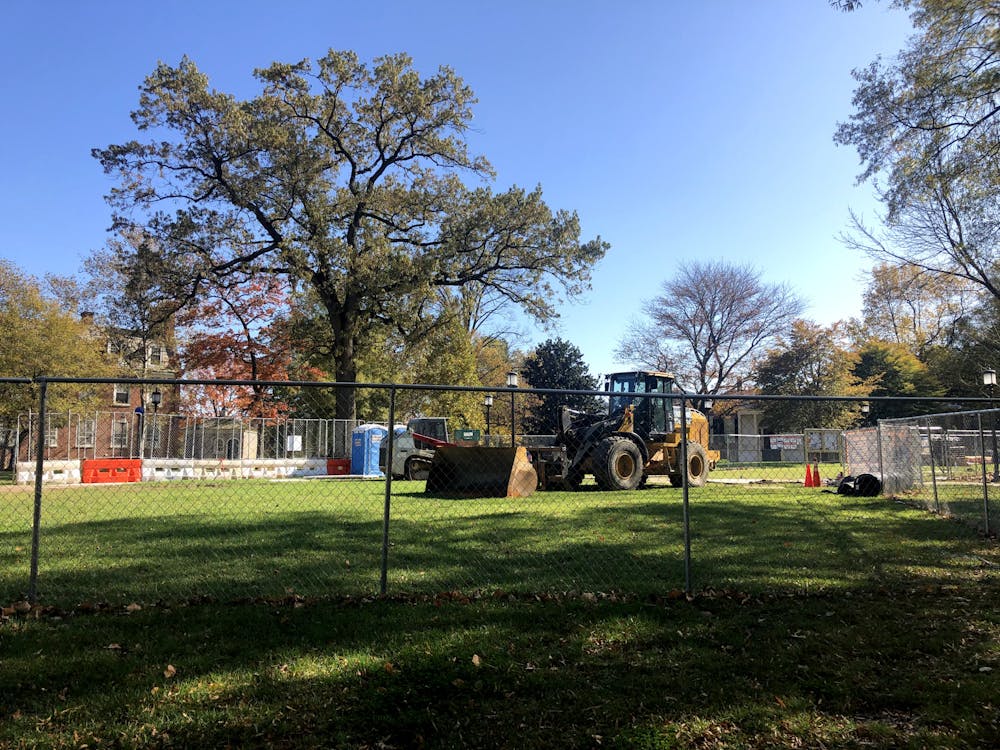Earlier this week, a wheel dozer and a metal wire mesh fence along with several portable toilets appeared on the Freshman Quad, the patch of grass in front of the Alumni Memorial Residence dorm buildings. Here the University is building a temporary 9,000-square-foot structure — essentially, a large party tent used for outdoor weddings — to prepare for the hybrid reopening in the spring semester.
In an email to The News-Letter, Assistant Vice President of External Relations for the Office of Communications Karen Lancaster shared that the structure will help facilitate socially distanced gatherings.
“It will serve students with access to power and Wi-Fi and be configured to support eating and/or studying within social distancing guidelines,” she wrote. “[Heating, ventilation and air conditioning] systems supplemented by operable windows will assure an abundance of fresh air throughout.”
Construction is expected to be completed by mid-January and is carried out by Whiting-Turner, a Baltimore-based construction company.

COURTESY OF THE SELECT EVENT GROUP
Many students who are currently in Baltimore for the remote fall semester have been utilizing various outdoor spaces on campus to study or have picnics. As winter approaches and temperature drops, students expressed concern that socially distanced outdoor gatherings will be less possible.
Freshman Christine Fernandez, who is currently living in University housing, believes more outdoor spaces are necessary to host safe gatherings.
“There needs to be more social distancing spaces on and around campus, especially indoor ones as it gets colder. There’s not really anything open to students at the moment,” she said. “In the spring students will definitely want to hang out in person or have academic or extracurricular meetups, and it’ll be hard to do safely without designated spaces.”
Several students also expressed the need for more outlets in outdoor spaces on campus. Junior Mario Aguirre, who lives in Charles Village, believes that it is difficult to work on campus for a long period of time.
“A majority of the student body doesn’t have access to buildings, so we have to resort to sitting outside in front of [Milton S. Eisenhower Library] and pulling chairs up from the quads,” he said. “It’s fairly easy to social distance on quads, but because of a lack of cables and the weather getting colder, it’s hard to actually do work and sit outside for long periods of time.”
Senior Lauren Paulet, who also lives in Charles Village, echoed Aguirre, noting how the lack of outlets has interrupted her work and forced her to relocate.
“They need to facilitate more outlets on campus,” she said. “Today when I was studying in the Breezeway, my computer was dying, so I had to leave campus because I couldn't charge my computer.”
Paulet expressed concern over whether the structure would be able to replicate the experience of studying in indoor spaces like the Hutzler Reading Room (HUT).
“It just feels less inspiring,” she said. “There’s something special about sitting in the HUT or the Mudd Atrium. It has its charm, and you miss out on that when you are studying in a white, sterile tent on the Freshman Quad. I'm curious to learn about how the University will make that place an inspiring place to study.”
Aguirre thinks the tent is an innovative idea to address the need for more socially distanced spaces on campus.
“It sounds pretty cool, so I don’t see why I won’t use it,” he said. “It seems like a good alternative and a creative solution. I’m glad they’re bringing back more study spaces.”
Sophomore Evelyn Shiang spoke about the challenges of socializing on campus with all University buildings closed. She explained that there are only a few, if any, indoor spaces for safe socialization.
“Social distancing while studying is pretty easy on campus,” she said. “But it's much harder to socialize and distance because it’s winter, and we don't have a lot of spaces for that anymore.”
Shiang expressed doubts that the structure could significantly reduce the risk of transmission compared to other indoor spaces of the University.
“I'm excited for it, but I do have concerns about how much more effective it will be than the existing indoor spaces that we have,” she said.





